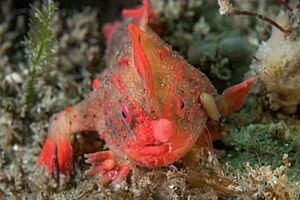Red handfish facts for kids
Quick facts for kids Red handfish |
|
|---|---|
 |
|
| Conservation status | |
| Scientific classification |
The red handfish (Thymichthys politus) is a very rare type of handfish. It lives only in Frederick Henry Bay, Tasmania, Australia. These special fish are known for using their "hand-like" fins to walk on the seafloor instead of swimming.
Contents
About the Red Handfish
The red handfish is easy to spot because of its bright red color. Its body is covered in small, bumpy spots that look a bit like warts.
There are two main color types, or morphs, of the red handfish:
- One type is bright red all over its body and fins. It has a thin black line that separates the red from white edges on its fins.
- The other type has a pink body with many red patches. Its fins are a see-through pink with some bright red spots.
These fish are quite small. They usually measure about 61.4 millimeters (2.4 inches) long from their snout to the start of their tail. Their total length, including the tail, is about 80.1 millimeters (3.2 inches).
Where They Live and How They Behave
Home and Habitat
In the past, red handfish were found in several places around Tasmania. These included Port Arthur, Fortescue Bay, and the D'Entrecasteaux Channel.
Today, they are only found in two very small areas in Frederick Henry Bay. These areas are small reefs, no more than 50 meters (164 feet) across.
Red handfish like to live where sand meets rocks on the seafloor. The rocks are often covered with seaweed, which helps the fish blend in. They can be found in water from 1 meter (3 feet) to 20 meters (65 feet) deep.
Reproduction and Life Cycle
The red handfish does not spread out much because it has a low reproduction rate. Unlike many fish that release eggs into the water, female handfish lay their eggs directly on the seafloor.
They lay their eggs at the base of seagrass plants. This usually happens between August and October. Each group of eggs, called an egg mass, has about 30 to 60 eggs. These eggs are connected by tiny tubes that hold them together.
Adult handfish guard their eggs carefully until they hatch. This protection helps the young fish survive.
What They Eat
Scientists do not know a lot about what red handfish eat. However, they do know that these fish eat small animals that live on the seafloor. Their diet includes small crustaceans (like tiny crabs or shrimp) and polychaete worms.
Protecting the Red Handfish
Threats to Their Survival
The red handfish faces many dangers because there are so few of them. Their populations are very small and spread out.
One big problem is the native purple urchin. These urchins eat too much seaweed, which the handfish need for shelter and for laying their eggs. When there is less seaweed, the handfish lose their homes.
Another threat comes from nearby towns. Water runoff from urban areas can bring pollution and dirt into the bay. This dirt can cover the seafloor and harm the seaweed habitat that red handfish love. If there is no good place for their eggs to attach, the eggs can be washed away by currents.
Scientists are also worried about warming ocean waters. This could affect how the handfish reproduce, how their eggs develop, what they eat, and how they escape from danger.
Conservation Status
The red handfish is considered a very endangered species. It is listed as "Critically Endangered" by the Australian government under the Environment Protection and Biodiversity Conservation Act 1999.
The IUCN, a global organization, also lists the red handfish as "Critically Endangered". In Tasmania, it is listed as "Endangered" under the state's Threatened Species Protection Act 1995. This means it is at very high risk of disappearing forever if we don't protect it.




